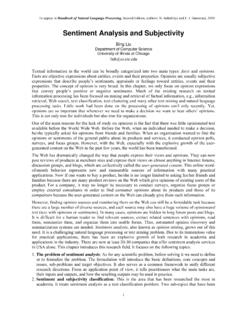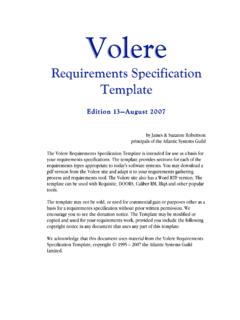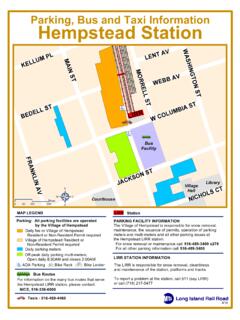Transcription of Where to Wait for a Taxi? - UIC Computer Science
1 Where to wait for a Taxi? Xudong ZhengState Key Laboratory ofSoftware DevelopmentEnvironmentBeihang UniversityBeijing, LiangState Key Laboratory ofSoftware DevelopmentEnvironmentBeihang UniversityBeijing, Xu State Key Laboratory ofSoftware DevelopmentEnvironmentBeihang UniversityBeijing, often have the demand to decide Where to wait for ataxi in order to save their time. In this paper, to address thisproblem, we employ the non-homogeneous Poisson process(NHPP) to model the behavior of vacant taxis. According tothe statistics of the parking time of vacant taxis on the roadsand the number of the vacant taxis leaving the roads in his-tory, we can estimate the waiting time at different times onroad segments. We also propose an approach to make recom-mendations for potential passengers on Where to wait for ataxi based on our estimated waiting time.
2 Then we evaluateour approach through the experiments on simulated passen-gers and actual trajectories of 12,000 taxis in Beijing. Theresults show that our estimation is relatively accurate andcould be regarded as a reliable upper bound of the waitingtime in probability. And our recommendation is a trade-off between the waiting time and walking distance, whichwould bring practical assistance to potential passengers. Inaddition, we develop a mobile applicationTaxiWaiteronAndroid OS to help the users wait for taxis based on ourapproach and historical and Subject [Database Management]: data mining, spatial data-bases and GISG eneral TermsModeling, Statistics, ExperimentationKeywordsVacant taxi , waiting time, poisson distribution1.
3 INTRODUCTIONT axis play an important role in the transportation of example, Beijing has more than 60,000 taxis to provide Corresponding to make digital or hard copies of all or part of this work forpersonal or classroom use is granted without fee provided that copies arenot made or distributed for profit or commercial advantage and that copiesbear this notice and the full citation on the first page. To copy otherwise, orrepublish, to post on servers or to redistribute to lists, requires prior specificpermission and/or a 12, August 12, 2012. Beijing, 2012 ACM 978-1-4503-1542-5/08/2012 ..$ for about 2,000,000 passengers every day. Howev-er, there are still many people often annoyed with waitingfor taxis. It is not only because of the imbalance betweensupply and demand, but also due to the lack of the vacan-t taxis information provided to passengers.
4 For example,if a person does not know that there is another road near-by with more vacant taxis passing by, he/she would spendmuch more time on waiting for a taxi in current passengers could choose a better road to waitfor taxis based on historical experiences. But more peoplehave little knowledge about like how long they would taketo wait for taxis here or Where is better to wait for taxis,especially in some strange places for them, which may affectthe their travels and schedules very this paper, we propose a method to estimate the waitingtime for a vacant taxi at a given time and place, and thenprovide an approach to make recommendations for potentialpassengers on Where to wait for a taxi . To make this estima-tion, we establish a model to describe the behavior of vacanttaxis.
5 Our model is based on the following observations: The higher proportion of time with vacant taxis parkingbeside the road, the more chances you can take a taxiimmediately here. This situation usually occurs duringthe idle time around some popular places. The more vacant taxis leaving a road, the more chancesyou can take a taxi quickly. The waiting time is affectednot only by the number of vacant taxis entering a road,but also by how many people want to take taxis here atthat time. Because we do not have the data to directlyshow the demand for taxis, we think the number of vacanttaxis leaving a road approximately reveals the remainingchance for a passenger to take a taxi here after the demandon the road is all by the two observations above, we adopt the non-homo-geneous Poisson process (NHPP) [11] to model theevents of vacant taxis leaving and derive the probabilitydistribution of the waiting time.
6 Then we could perform es-timations and recommendations based on the also do some experiments to demonstrate that our ap-proach is practicable and then develop a mobile applicationto help people wait for study is built upon the GPS trajectories of taxis in Bei-jing, China. This data is collected from more than 12,000taxis, which account for about one-fifth of total ones in thecity. We select the data between Oct. 2010 and Jan. 2011to study. Each GPS record contains the identifier of a taxi ,current position, timestamp, service status, and some oth-er information. The data sampling interval of each taxi isabout 60 major contributions of our work include: We employ the NHPP to model the behavior of vacanttaxis, which could approximate the real situation well andhave a simple form to derive the probability distributionof waiting time.
7 We estimate the waiting time for vacant taxis at differenttime on road segments, analyze the confidence of our esti-mation, and design a recommender system for the peoplewho want to take taxis. We conduct a lot of experiments to evaluate our approachon simulated passengers and actual trajectories of results show that our estimation is relatively accurateand our recommendation would be helpful to potentialpassengers. We put our approach into practice by developing a mobileapplication which could help the user find an appropriateplace to wait for a rest of this paper is organized as follows. In Section2, we give an overview of the related work. Section 3 in-troduces our model used to estimate the waiting time for avacant taxi .
8 Section 4 describes the data processing of ourwork. In Section 5, we analyze the results of our estimat-ed waiting time. Then, we discuss the recommendation forpassengers in Section 6. Section 7 shows the experimentsand evaluations on our approach. Section 8 introduces anapplication we developed to help people wait for taxis. Fi-nally, we make a conclusion and propose some future workin Section RELATED Recommendations about TaxicabsRecent years have witnessed the explosive research intereston taxi trajectories [1, 6, 7, 14, 18]. Moreover, many workshave also been done to investigate the recommendations fortaxi passengers or drivers [2, 5, 9, 13, 17].Phithakkitnukoon et al. [9] study the prediction of vacan-t taxis number to provide the information for tourists ortaxi service providers.
9 They employ the method based onthe na ve Bayesian classifier and obtain the prior probabilitydistribution from the historical data. However their methoddivides the region of the city into one-kilometer square grid-s which are too rough to provide practical information forpassengers. In addition, their data is only from the tracesof 150 taxis in Lisbon, which might not be enough to re-veal laws of vacant taxis for the reason of weak et al. [2] develop a recommender system for taxi driverswhich has the ability in recommending a sequence of pick-uppoints or parking positions so as to maximize a taxi driver sprofit. They estimate the probability of pick-up events foreach candidate point, and then propose an algorithm to dis-cover a route with minimal potential travel distance beforehaving customer.
10 Li et al. [5] study the strategies for taxidrivers as well. They use L1-Norm SVM to discover the mostdiscriminative features to distinguish the performance of thetaxis, and then extract some driving patterns to improve theperformance of the taxis. However, all these studies do notconcern about the recommendation for et al. [17] propose an approach to make recommenda-tions for both taxi drivers and passengers. They establisha probabilistic model to describe the probability to pick-uppassengers, the duration before the next trip, and the dis-tance of the next trip for a vacant taxi . Then they providesome different strategies for taxi drivers, each of which isbased on the optimization of one aspect (probability of pick-up, cruising time, or profit).


















![Untitled-1 [www.miami-airport.com]](/cache/preview/a/6/6/4/e/3/2/a/thumb-a664e32aa7cef4c29ae356ee62c18f38.jpg)
